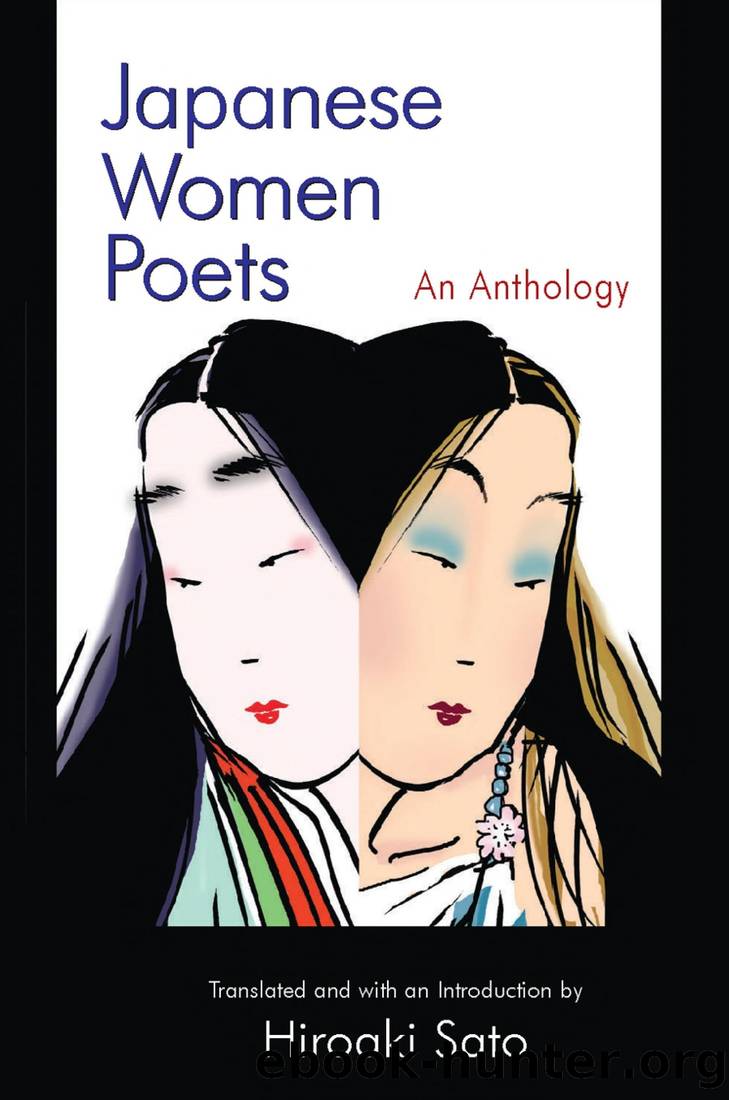Japanese Women Poets: An Anthology: An Anthology by Hiroaki Sato

Author:Hiroaki Sato [Sato, Hiroaki]
Language: eng
Format: epub
Tags: Political Science, General, Public Policy, Economic Policy
ISBN: 9781317466970
Google: 5UffBQAAQBAJ
Amazon: 0765617838
Publisher: Routledge
Published: 2014-12-18T06:00:00+00:00
Interludes
A Brief Survey of Senryū by Women
The 5-7-5-syllable senryÅ«, like the hokku, derives from the longer verse form of renga. But unlike the hokku, which normally deals with natural or seasonal phenomena, the senryÅ« is expected to deal with matters of human and social nature, often in a playful, satirical, or knowing manner. The hokkuâcalled haiku todayâcarries a seasonal reference; the senryÅ« doesnât have to.
The distinction between the two genres of verse has been tenuous at best from early on, however, and in recent years the blurring of the differences has become such that Ånishi Yasuyo has said, âIf someone asks me how senryÅ« differ from haiku, I tell the inquirer that the only distinction that can be made is by authorâs nameââthat is, if the author is known to write haiku, the pieces he or she writes are haiku; if the author is known to write senryÅ«, the pieces she or he writes are senryÅ«. Ånishi herself is sometimes listed as a senryÅ« poet, sometimes as a haiku poet.
Modern senryÅ«, which dates from about the time of the haiku reform efforts of Masaoka Shiki (1867â1902), has taken such divergent perspectives as idealism (âthe theory,â as an English dictionary puts it, âthat the objects of external perception, in itself or as perceived, consist of ideasâ), proletarianism, social realism, and individualism (âthe tendency,â as a haiku dictionary puts it, âto sink deeply into oneâs own individualityâ).
One senryÅ« observer has noted that if the period of 250 years since the senryÅ« was established as a genre were to be divided into five ages, this would be the fifth, and women writers have dominated it. In the early part of the twentieth century, women senryÅ« writers were, the pioneering Inoue Nobuko said, âfewer than the stars at daybreak. â
What follows is a brief survey of senryÅ« by women. Most of the selection is made from Taira SÅseiâs anthology with commentary, RyÅran Josei SenryÅ« (Midori ShobÅ, 1997).
Sakai Sobaijo (Died 1952)
A mother of seven children, Sakai Sobaijo was one of the first women to take up senryÅ« in the Meiji era. Her husband was Sakai Kuraki (1869â1945), a leader in the Meiji senryÅ« revival among whose senryÅ« is âKuraki has become a fool called a teacher,â which is a twist on an anonymous senryÅ«, âHeâs not such a fool as to be called a teacher.â
At every command he gives the second lieutenant jumps up
In a sudden shower a woman covers her obi first
Unable to compose a single piece on plum flowers she comes home
She says âsheeee!â to a burglar thinking heâs a rat
Receiving the evening sun a fishing boat is left in the dark
ItÅ Masajo (Born 1882)
âA woman experiences frustrations,â ItÅ Masajo said, âas an old woman, a little girl, a bride, a second wife, and a widow. She must capture such weaknessesâ in her senryÅ«. She was prolific and once turned Chinaâs classical novel The Water Margin into a sequence of 285 senryÅ«. But she had disappeared from the senryÅ« world by 1920.
Cupid often
Download
This site does not store any files on its server. We only index and link to content provided by other sites. Please contact the content providers to delete copyright contents if any and email us, we'll remove relevant links or contents immediately.
The Universe of Us by Lang Leav(14845)
The Sun and Her Flowers by Rupi Kaur(14349)
Adultolescence by Gabbie Hanna(8609)
Whiskey Words & a Shovel II by r.h. Sin(7820)
Love Her Wild by Atticus(7600)
Smoke & Mirrors by Michael Faudet(5950)
Wiseguy by Nicholas Pileggi(5346)
The Princess Saves Herself in This One by Amanda Lovelace(4827)
Love & Misadventure by Lang Leav(4703)
Milk and Honey by Rupi Kaur(4606)
Memories by Lang Leav(4586)
Bluets by Maggie Nelson(4289)
Too Much and Not the Mood by Durga Chew-Bose(4110)
Good morning to Goodnight by Eleni Kaur(4108)
Pillow Thoughts by Courtney Peppernell(4043)
Algedonic by r.h. Sin(3892)
The Poetry of Pablo Neruda by Pablo Neruda(3836)
HER II by Pierre Alex Jeanty(3481)
Stuff I've Been Feeling Lately by Alicia Cook(3319)
